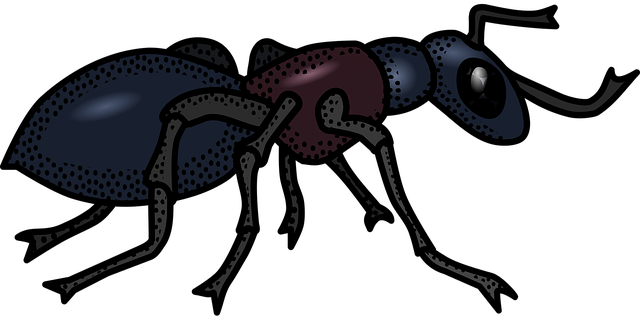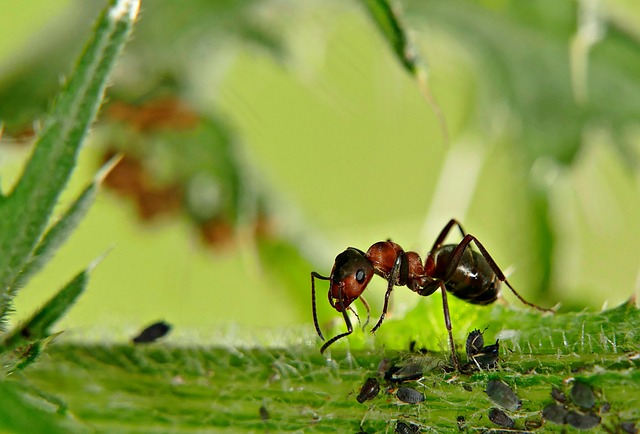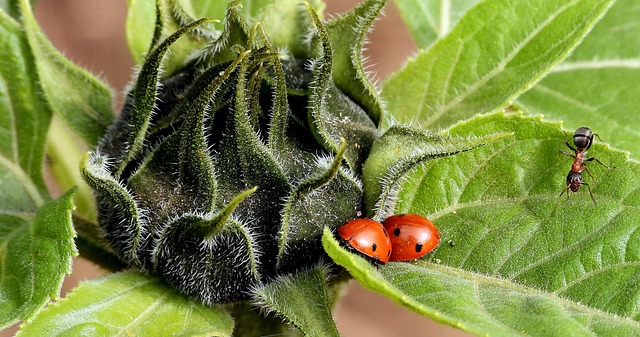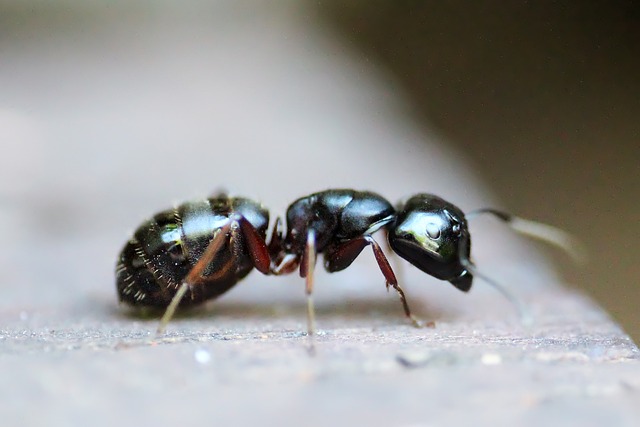Understanding ant behaviors and habitats is crucial for effective ant control. This involves recognizing their complex social structures, navigation methods, and varied preferences for nesting and foraging. Tailoring ant control strategies based on these factors ensures success in blocking entry points, eliminating food sources, and using targeted treatments. Professional pest management uses tools like baiting systems, insect growth regulators (IGRs), and targeted pesticides to disrupt ant trails and nests. Customized prevention strategies involve regular inspections, sealing entry points, maintaining cleanliness, and removing attractants. Effective ant removal techniques include identifying specific ant species, using baits, insecticides, and natural repellents, and employing integrated pest management (IPM) strategies. Ongoing vigilance, cleaning practices, and periodic monitoring are essential for long-term ant control. Green and safe solutions, utilizing natural repellents and least toxic materials, are increasingly popular to preserve ecological balance and protect non-target species.
Looking to reclaim your space from ants? Discover tailored ant control plans that offer effective, long-lasting solutions. This comprehensive guide delves into understanding ant behaviors and habitats, identifying the best control methods for your specific situation, and crafting a prevention strategy that works. Learn proven techniques for safe and eco-friendly ant removal, monitoring results, and maintaining long-term control. Take back your home or business with our expert advice on ant control.
Understanding Ant Behaviors and Habitats

Understanding ant behaviors is a crucial step in implementing effective ant control measures. Ants are highly organized and efficient creatures, often forming colonies with complex social structures. They communicate through pheromones, which help them locate food sources, mark trails, and coordinate activities within their colony. Different species of ants have distinct preferences for habitats, ranging from forests to urban settings, each with unique nesting sites and foraging patterns. Identifying these behaviors and habitats is essential in tailoring ant control strategies, ensuring that interventions are specific, safe, and successful.
Ants tend to establish nests near food sources, which can include both natural materials and human food items. They create intricate networks of tunnels and chambers within their nests, providing safe havens for the colony. When ants invade homes or commercial spaces, it’s because they’ve discovered a readily available food source. Effective ant control involves blocking these entry points, eliminating food sources, and using targeted treatments to disrupt the colony without harming non-target species. By understanding ant biology and behavior, professionals can develop customized plans that address specific issues, providing lasting solutions for ant control.
Identifying the Right Ant Control Method

Identifying the most effective ant control method is a crucial first step in any ant management strategy. This process involves understanding your specific ant species, their behavior patterns, and the extent of the infestation. Different ants require distinct approaches; some may thrive in outdoor environments, while others have made their way indoors.
Professionals employ various tools in their ant control arsenal, including baiting systems, insect growth regulators (IGRs), and targeted applications of pesticides. The right method will disrupt ant trails, eliminate nests, and prevent future invasions. By tailoring the control strategy to the particular needs of your property and the ants present, you ensure more successful and sustainable results in the battle against these persistent intruders, offering lasting relief from ant control concerns.
Creating a Tailored Ant Prevention Strategy

When it comes to ant control, a one-size-fits-all approach rarely works. That’s why creating a tailored ant prevention strategy is essential for effective management. It involves understanding the unique dynamics of your environment, including identifying the specific ant species, their preferred habitats, and the sources of food attracting them. By conducting a thorough inspection, you can pinpoint problem areas and develop targeted solutions.
This strategy should include measures like sealing entry points, maintaining cleanliness, and removing potential food sources. For instance, storing food in airtight containers and regularly cleaning surfaces can disrupt ant trails and deter their return. Additionally, landscaping practices can play a role; keeping vegetation trimmed and removing excessive debris reduces hiding places and hinders their movement. A combination of these tailored methods forms the backbone of successful ant control, ensuring your space remains pest-free.
Implementing Effective Ant Removal Techniques

Implementing effective ant removal techniques is key in achieving successful ant control. The first step involves identifying the specific species of ants infesting your space, as different ants require distinct approaches. Once identified, targeted treatments can be administered, using a combination of baits, insecticides, and natural repellents. Ant baits are particularly effective as they attract worker ants, which then carry the toxin back to their colony, eliminating the queen and disrupting the overall population.
Professional pest control services often employ integrated pest management (IPM) strategies, utilizing less toxic methods initially and escalating as necessary. Regular cleaning and sanitation practices play a crucial role in ant prevention. Removing food sources, sealing entry points, and maintaining a clean environment significantly reduce the likelihood of an ant invasion. By combining these techniques, homeowners can effectively manage and control ant infestations, ensuring a pest-free living space.
Monitoring and Maintaining Long-term Control

Effective ant control goes beyond a single treatment; it requires ongoing monitoring and maintenance for long-term success. This involves regular inspections to identify any signs of ant activity, such as trails, nest locations, or fresh damage. By staying vigilant, you can catch ant infestations early, preventing them from becoming established and reducing the need for more intensive treatments.
Maintaining control also includes keeping your environment unappealing to ants. This means addressing any food sources, sealing entry points, and maintaining a clean living space. Regular cleaning routines, proper waste management, and storing food in airtight containers can significantly deter ants. Combining these preventive measures with periodic monitoring ensures a robust ant control strategy that offers lasting protection.
Green and Safe Ant Management Solutions

In today’s world, effective yet green and safe ant management solutions are increasingly in demand. Traditional methods often rely on toxic chemicals that can harm both ants and beneficial insects, as well as the environment. However, customized ant control plans offer a more eco-friendly approach. These tailored strategies utilize natural repellents, biological controls, and targeted applications of least toxic materials to eliminate ant infestations without leaving behind harmful residues.
By implementing these green solutions, homeowners and businesses can effectively manage ant populations while preserving the ecological balance. Customized plans take into account unique environmental factors and the specific types of ants present, ensuring that only necessary measures are taken. This not only protects non-target species but also promotes a healthier and more sustainable environment for everyone involved.
